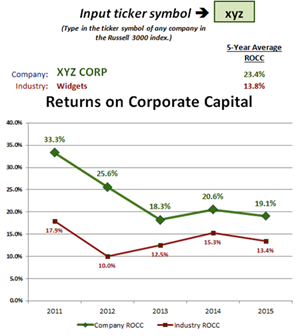|
Forum Report:
Requested new program and
workshop for “metrics”
Defining a
Simple Measure of “Returns on Corporate Capital”
Your views
will be appreciated to guide the final development of a standard “Returns
on Corporate Capital” (“ROCC”) measurement. Initiated a month ago as a
subordinate task in our workshop project to define metrics for analyzing
stock buybacks,[1]
the effort to make it simple proved to be surprisingly complicated.
What we
propose is a calculation based purely on GAAP-defined numbers, as reported
by companies in their SEC filings:
net
income plus interest expense and income taxes,
divided
by
the prior
year’s ending balance of total assets
less
current liabilities other than short-term debt
|

To use the workshop test graph online,
click
here.
|
The use
of standardized, GAAP-defined terms is important to allow collection
of consistent data from all SEC-registered U.S. companies, so that they
can be meaningfully compared over time and with each other, and with
industry or other groupings of companies. This also allows anyone to
obtain the same source data from publicly accessible SEC records, as well
as from research services, so that they can independently perform or
confirm a ROCC analysis.
This ROCC
definition is of course similar to many definitions of “ROIC” (return on
invested capital), but avoids both the confusion and debates resulting
from all the GAAP and non-GAAP variations of ROIC calculations among
research services, analysts and companies that present their own “right”
way.[2]
Please use
the test version of a ROCC graphing tool, illustrated here and now
embedded on a
website
established for our “metrics” workshop,
to review the measurement and consider its applications to whatever
analyses you may want to perform. The currently posted online tool is of
course designed only for workshop development use, as you’ll see from its
slow responses and limited universe of companies. We will be trying to
establish specifications for a final public version during the next couple
of weeks, so will welcome any advice you can offer to guide our refinement
of the graphing tool as well as the ROCC analysis.[3]
These are
some of the questions we are currently considering:
1.
Should
the calculation of ROCC be further refined?
2.
Should
the universe of companies include all SEC-registered U.S. companies, or
only a subset such as the Russell 3000 or S&P 1500?
3.
Should
calculations of industry comparisons exclude the subject company, as
currently specified, or include the subject company in the total?
4.
Should
industry classifications be based on the Global Industry Classification
Standard (GICS) codes assigned by the Standard & Poor’s staff, which are
used by many financial professionals, or on the Standard Industrial
Classification (SIC) codes identified by companies themselves in their SEC
filings, which are more broadly established?
It will also
be very helpful to know how you would like to be able to use ROCC
analyses. For example, while our interest in it was stimulated by the need
for rational evaluations of stock buyback proposals, some of our workshop
participants are primarily interested in applying ROCC analyses to
executive compensation policies. We want the analysis, and the tools for
its use, to be readily applicable to any kind of corporate performance
analysis.
Our
objective is to focus on a practical measure of profits generated from
using corporate capital in the competitive production of goods and
services. That, as the Forum has emphasized, is the only real foundation
of corporate value, and of economic prosperity.
GL – June
16, 2016
Gary Lutin
Chairman,
The Shareholder Forum
575 Madison
Avenue, New York, New York 10022
Tel:
212-605-0335
Email:
gl@shareholderforum.com
|